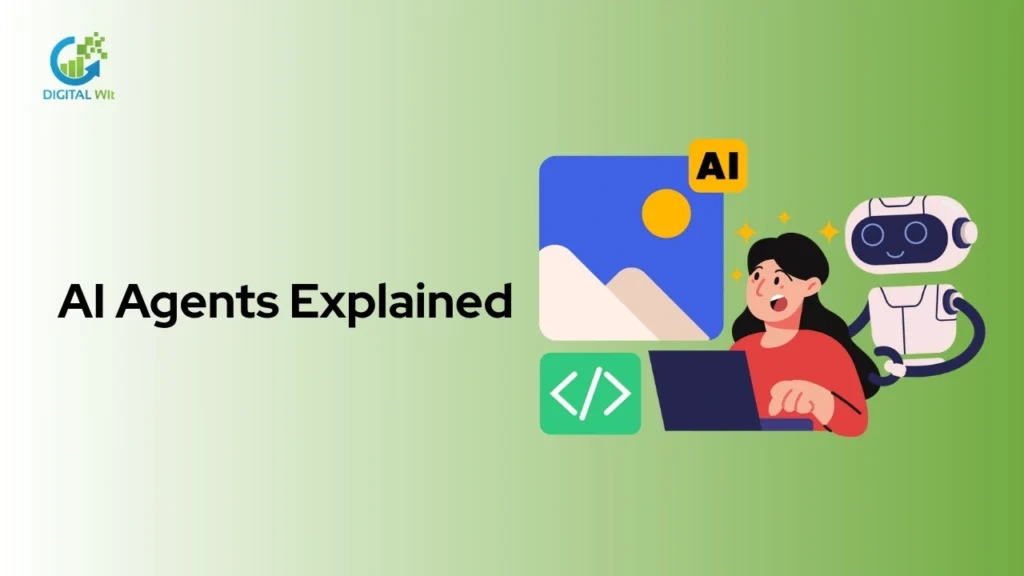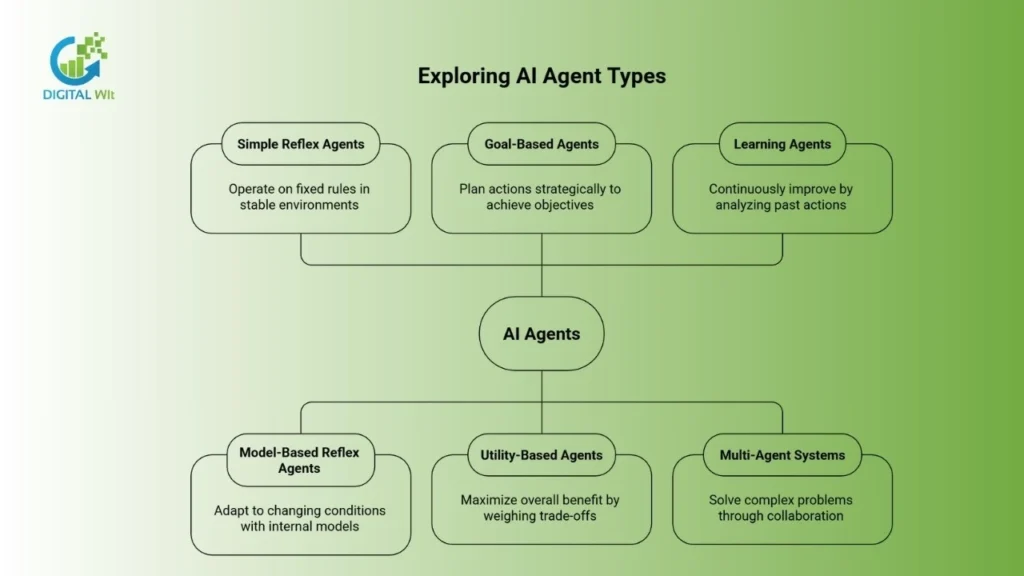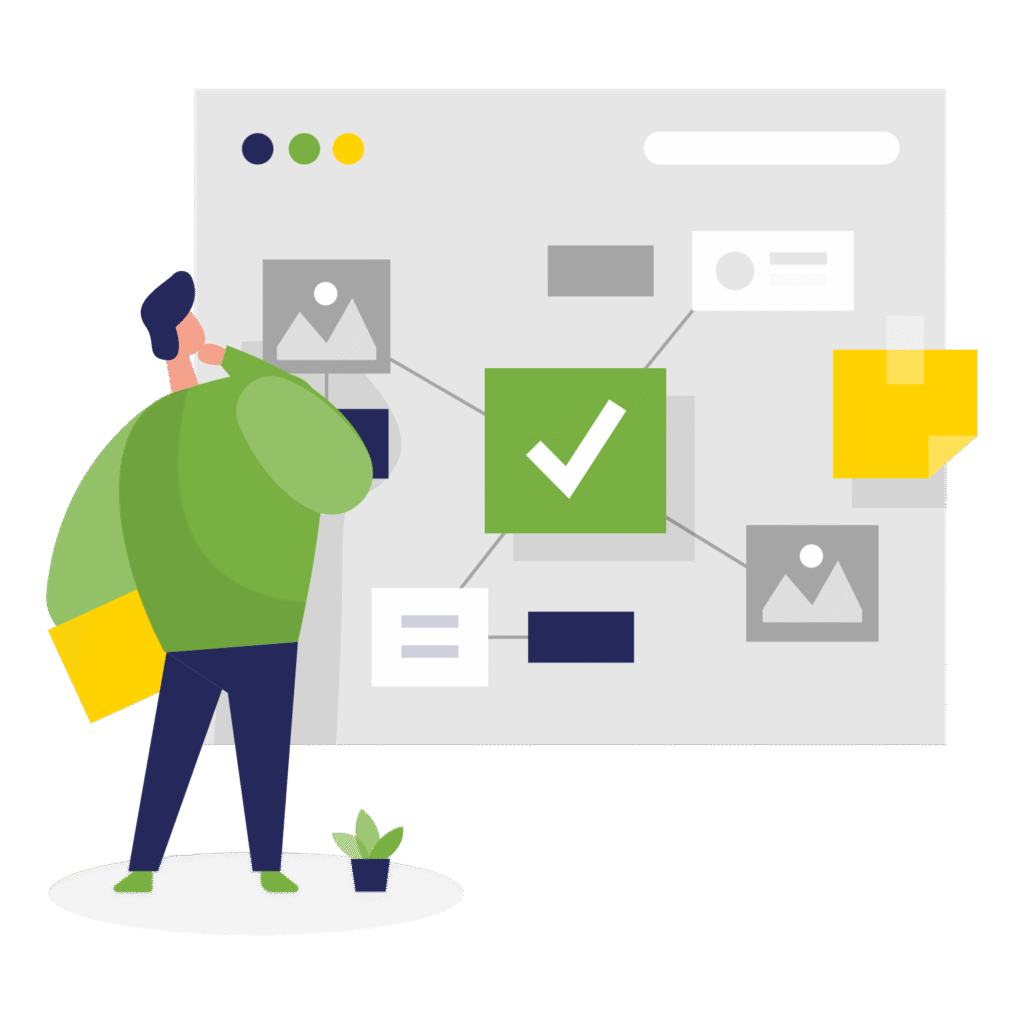Understanding AI agents, their types, functions, and real-world applications, is no longer optional. For businesses that want to stay competitive, grasping how these autonomous systems work is as important as understanding the market itself.
Most people think of AI as chatbots or flashy automation tools, but the real game-changer isn’t the interface, it’s the agent behind it. AI agents don’t just execute tasks; they observe, reason, and decide autonomously. They adapt to unexpected situations, learn from outcomes, and optimize processes in ways that traditional software simply cannot.
These agents are quietly reshaping industries: a logistics AI reroutes shipments in real-time to avoid delays, a finance AI detects fraud before it happens, a healthcare AI monitors patient data and suggests treatments before symptoms escalate. They operate behind the scenes, yet their impact is immediate, measurable, and often invisible.

Key Takeways:
- AI agents are autonomous systems that perceive, reason, act, and learn to achieve goals.
- They require an environment, sensors, actuators, and a learning module to function effectively.
- AI agents work in a loop of perception, decision-making, action execution, and feedback learning.
- They can be simple reflex, model-based, goal-based, utility-based, learning, or multi-agent systems.
- AI agents improve operations in customer support, healthcare, finance, manufacturing, logistics, education, and cybersecurity.
- They increase efficiency, operate 24/7, scale easily, provide data-driven insights, and continuously learn.
- Challenges include bias, transparency issues, implementation complexity, and the need for human oversight.
- AI agents are advancing toward agentic AI, IoT integration, multi-agent coordination, and hyper-personalization.
What Is an AI Agent?
An AI agent is fundamentally an autonomous system. It perceives its environment. It interprets and reasons over data. It acts to achieve defined objectives. It continuously learns from outcomes to improve efficiency, accuracy, and reliability.
They function like highly focused students. They learn from every interaction. They anticipate problems before they occur. They adjust approaches without direct supervision.
More Than Smart Programs
They are not just “smart programs”. They evaluate potential actions. They calculate consequences. They adapt when conditions change unexpectedly.
Organizations increasingly rely on AI agents to automate workflows. They provide predictive insights. They manage operations at a scale and speed humans cannot match.
Integrating AI agents in daily operations enables teams to streamline work. They can focus on strategic and creative priorities.
Key Components of an AI Agent
Every AI agent requires several core components to function effectively:
Environment: The external or virtual setting in which the agent operates. This includes physical surroundings, datasets, or connected systems. It provides critical context that influences its decisions, responses, and learning trajectory.
Sensors: Mechanisms for perceiving the world. These can include cameras, microphones, IoT devices, user inputs, APIs, or environmental feedback. This allows the agent to continuously collect actionable information from multiple sources simultaneously.
Actuators: Tools or interfaces that allow the agent to perform actions. These include sending messages, updating databases, controlling robotic arms, or modifying software parameters. They translate decisions into real-world outcomes reliably.
Knowledge Base & Learning Module: Memory and adaptive components store historical data, patterns, and previous actions. This enables the agent to improve continuously. It avoids repeated mistakes. It anticipates outcomes. It optimizes strategies based on experience
Together, these elements create a dynamic feedback loop. This allows agents to operate autonomously while remaining contextually aware and continuously improving their performance.
How AI Agents Works
AI agents follow a cycle that can be broken down into sequential stages:
1. Perception
Gathering and interpreting data from sensors, APIs, user interactions, or environmental inputs. This builds an accurate understanding of the current state. It enables informed decision-making.
2. State Representation
Structuring raw input into actionable knowledge that guides decisions effectively. This forms a “mental model” of the environment that supports reasoning and predictions.
3. Decision-Making
Evaluating possible actions using goal-based logic, utility functions, or predictive models. This determines the optimal path forward. It balances trade-offs and anticipates consequences.
4. Action Execution
Implementing chosen actions autonomously through software interfaces, robotic mechanisms, or communications. This ensures precise, timely, and consistent results.
5. Feedback & Learning
Assessing outcomes. Updating internal models. Recognizing patterns. Refining strategies for future tasks. This enables continuous improvement and adaptability
This loop allows AI agents to execute multi-step processes with minimal human intervention. They dynamically respond to new circumstances.
Types of AI Agents

AI agents vary in autonomy, adaptability, and intelligence. Each type offers specific advantages depending on the environment and task complexity:
Simple Reflex Agents
Operate on fixed rules and respond only to predefined inputs. They perform repetitive tasks reliably. But they cannot learn, adapt, or handle unexpected scenarios. This makes them ideal for stable environments where predictability is paramount.
Model-Based Reflex Agents
Maintain an internal model of their environment. This enables them to adapt when conditions change. They anticipate consequences. They track multiple variables simultaneously.
These agents are particularly useful in partially observable or dynamic environments. Constant monitoring and adjustment are necessary.
Goal-Based Agents
Plan actions strategically to achieve specific objectives rather than reacting impulsively. They evaluate multiple approaches. They predict potential obstacles. They select actions that efficiently reach outcomes.
This makes them suitable for optimization tasks and strategic problem-solving.
Utility-Based Agents
Assess multiple possible outcomes to select actions that maximize overall benefit. They weigh trade-offs, risks, and rewards simultaneously.
They optimize complex systems such as financial portfolios, logistics networks, or marketing campaigns.
Learning Agents
Continuously improve by analyzing previous actions. They recognize patterns. They refine strategies over time. This enables them to anticipate needs, improve efficiency, and deliver personalized interactions across industries..
Multi-Agent Systems
Multiple agents operate collaboratively, competitively, or hierarchically to solve complex problems. Through communication, coordination, and shared knowledge, these systems manage tasks that exceed a single agent’s capacity.
Examples include global supply chains, traffic management, or distributed computation.
Applications Across Industries
AI agents are not just ideas. They are changing how businesses work by doing tasks automatically, analyzing data, and making decisions on their own. They save time, reduce mistakes, and let humans focus on more important work.
Customer Support

AI agents can handle large numbers of customer questions at the same time. They track requests, give fast answers, and provide personalized help. If a problem is too complex, they can pass it to human staff.
By learning from past interactions, they improve responses over time. This makes support faster, more accurate, and more helpful for customers, while reducing stress for support teams.
Healthcare
AI agents help doctors and nurses by checking medical images, lab results, and patient records. They can monitor patients continuously and spot unusual patterns or early warning signs.
AI agents can suggest treatment plans or highlight risks, helping healthcare staff make better decisions. Hospitals can provide faster care and avoid mistakes, improving patient safety and outcomes.
Finance
In finance, AI agents can spot unusual transactions and prevent fraud. They can analyze market data and make automatic trades using safe strategies. They also assess risks for investments or loans and help banks make smarter decisions.
These agents improve security, save time, and reduce human errors in complex financial processes.
Manufacturing
AI agents manage machines and robots on production lines. They can predict when equipment might fail and schedule maintenance before problems happen.
They adjust workflows automatically to keep production running smoothly and maintain product quality. This helps factories reduce downtime, save money, and deliver consistent products.
Transportation and Logistics
AI agents plan the best routes for deliveries, coordinate fleets of trucks or drones, and track shipments in real time. They can change routes if there is traffic, weather issues, or delays.
By optimizing travel and schedules, AI agents save time, reduce fuel use, and make supply chains more reliable and cost-effective.
Education
AI agents help teachers and students by tracking learning progress and giving lessons that match each student’s needs. They can provide practice exercises, feedback, and guidance for areas where students struggle.
This personal attention improves learning outcomes, helps students stay engaged, and allows teachers to spend more time on teaching rather than manual monitoring.
Cybersecurity
AI agents protect companies from attacks by monitoring networks and systems all the time. They can detect unusual activity or threats and respond immediately to stop potential breaches.
This reduces the risk of data loss or system failure and ensures that cybersecurity teams can focus on higher-level security tasks instead of constant monitoring.
Across all these industries, AI agents are becoming essential tools. They help businesses operate faster, make fewer mistakes, and let humans focus on creative and strategic work.
Organizations looking to improve operations can rely on experts to integrate AI agents across AI-driven marketing solution, customer support, finance, and logistics. Companies that use AI agents effectively gain efficiency, reliability, and a competitive advantage in their field.
Why AI Agents Are Useful
AI agents help businesses get work done faster and more accurately than humans. They can work all day and night without getting tired.
In customer support, they can answer hundreds of questions at once and learn from past interactions to improve replies.
In finance, they monitor transactions continuously to detect fraud and reduce risk. AI agents also help companies grow without adding extra costs. By analyzing data, they provide insights that guide better decisions.
Over time, they improve workflows, strategies, and deliver results tailored to the business needs.
Problems Businesses Can Face With AI Agents
AI agents are powerful, but they can cause issues if not managed properly. Bias in data can lead to wrong or unfair decisions. Some results may be hard to understand because the system is complex.
Setting up AI agents needs technical skills for integration, testing, and monitoring. In healthcare, for example, an AI suggesting treatments must be checked carefully to avoid mistakes. Relying too much on AI without human oversight can lead to wrong outcomes.
Keeping a balance between AI autonomy and human guidance ensures the agents help humans rather than replace them.
Future Trends and Opportunities
AI agents are advancing toward agentic AI. They exhibit independence, context-awareness, and advanced coordination across multiple systems.
- IoT integration enabling seamless coordination across physical devices
- Multi-agent systems managing increasingly complex, layered workflows
- Cross-domain learning that allows knowledge transfer between industries
- Hyper-personalization in marketing, operations, and customer experience
AI agents are becoming foundational infrastructure. They quietly power critical business processes globally.
Final Thoughts
AI agents are collaborators that amplify human potential. They improve efficiency. They optimize decisions. They enable focus on creativity and strategy.
From understanding AI agent memory and learning to deploying autonomous, semi-autonomous, or learning agents, the opportunity for enhanced performance and insight is immense.
Businesses embracing AI agents today are laying the foundation for industry leadership tomorrow.
At Digital Wit – the best digital marketing agency for AI-driven growth, we help businesses integrate AI agents into operations strategically.
Combining AI intelligence with marketing expertise allows organizations to achieve operational excellence, measurable growth, and competitive differentiation.
The future isn’t coming. It’s here. It’s accelerating. And it runs on agents.
FAQs
How do AI agents operate?
They follow a loop of perceiving, reasoning, acting, and learning. They refine strategies with each cycle. This allows them to handle both predictable and unpredictable scenarios efficiently.
Why are AI agents important for businesses?
They handle high-volume, repetitive, or complex tasks autonomously. They provide actionable insights. They optimize decision-making processes. This enables humans to focus on creativity and strategy.
What is the difference between AI agents and LLMs?
While LLMs specialize in natural language generation, AI agents combine reasoning, memory, action, and planning to execute multi-step tasks across systems.
What does the future hold for AI agents?
The rise of agentic AI is creating systems that are increasingly independent, context-aware, and capable of multi-agent coordination. This makes them critical for enterprise and SME adoption.
When are multi-agent systems more effective?
- Complex problems exceeding single-agent capacity
- Traffic management coordinating hundreds of vehicles
- Supply chain optimization across global networks
- Distributed problem-solving scenarios
- Situations requiring specialization across multiple agents
What are the main challenges implementing AI agents?
- Data bias creating skewed outcomes
- Implementation complexity requiring specialized expertise
- Continuous monitoring demands
- Job displacement concerns
- Ethical considerations
- Transparency and explainability limitations in some systems
























